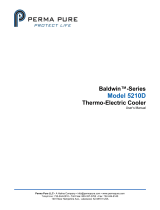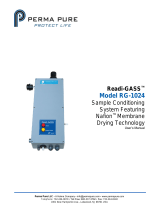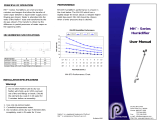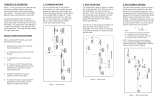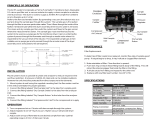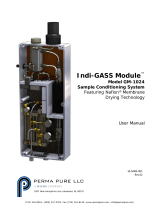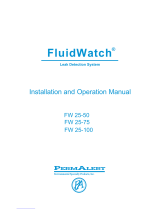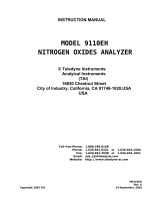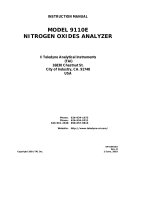Page is loading ...

Perma Pure LLC • A Halma Company • inf[email protected] • www.permapure.com
Telephone: 732-244-0010 • Toll Free: 800-337-3762 • Fax: 732-244-8140
1001 New Hampshire Ave., Lakewood, NJ 08701 USA
Baldwin™-Series
Model M115D
Digital
Thermo-Electric Cooler
User’s Manual

Model M115D User’s Manual
Doc. SE-MAN-057: Revision: 00
Page 2 of 28
©2018 Perma Pure LLC. All rights reserved. Specifications subject to change.
CONTENTS
3. Important Safety Warnings
4. Unpacking
4. Introduction
5. Principle of Operation
5. Limitations
6. Key Components of a Thermo-Electric Cooler
7. Physical Description
7. Specifications
8. Available Options
9. Installation
9. Hardware required for installation
9. Mounting
10. Electrical Connections
11. Sample Gas Connections
12. Basic Operation
12. Controller
13. Controls and Display
13. LED Summary
14. Start-up
15. Maintenance
16. Troubleshooting
21. Replacement Parts
22. Board Connections
25. Appendix A: Cooler Drawings
26. Appendix B: Sample Conditioning System
Drawings
27. Appendix C: Conversion Table
28. Appendix D: Warranty and Disclaimer

Model M115D User’s Manual
Doc. SE-MAN-057: Revision: 00
Page 3 of 28
©2018 Perma Pure LLC. All rights reserved. Specifications subject to change.
IMPORTANT SAFETY WARNINGS
Please be sure to review the following basic safety procedures. These procedures represent the
MINIMUM requirements to operate the equipment safely. It is the ultimate responsibility of the
operator to ensure proper safety practices are utilized at the point of operation.
• NEVER attempt to operate this equipment in an explosive, wet, or otherwise hazardous area.
• NEVER exceed any specified rating for the equipment. Voltage, temperature and pressure ratings
must be closely observed and not exceeded. Voltage rating of the equipment MUST match the rating
on the data label. Please make sure that it matches before powering up the equipment.
• Condensate is potentially dangerous. NEVER handle drain lines, impingers or any other item that
may have come in contact with the gas stream or any hazardous material, without adequate personal
protective equipment. ALWAYS assume that any liquid present is hazardous.
• Sample gas is potentially dangerous. A leak test is recommended at initial start-up and as often as
necessary to maintain a safe working environment around the equipment. The gas stream exhaust
must exit away from all personnel to prevent dangerous exposure.
• NEVER operate the equipment with any part of the enclosure unsecured. All operated doors and
covers must be in place and secured prior to operation. Electrical current may be present behind
covers or doors, even if tools are not necessary to access these components.
• NEVER attempt service on this equipment without first disconnecting all energy sources. Repair of
this equipment should only be done by properly trained personnel that are familiar with the potential
risks involved with servicing of the equipment.
• NEVER replace fuses with types other than the sample specification of type and current. Do not
bypass this or any other safety device.
• NEVER operate this equipment if it is visibly damaged or the possibility exists that it may have been
damaged.
• The use of components that have not been purchased through an authorized Perma Pure dealer or
directly from Perma Pure may compromise the safety of the operator. Additionally, use of non-
authorized components may change the operating characteristics of this equipment. Any changes to
the equipment, that modify its operation in any way, are dangerous, and are strictly prohibited.
• Read the entire operating manual before attempting to set up or operate the equipment.
• Please heed all warning labels on the equipment. They are there to remind you of possible hazardous
conditions.
• Verify the integrity of any mechanical and/or electrical connections that are made to the unit.
o Verify that the unit is connected to the properly rated power for the system.
o Verify that the unit is plumbed properly to operate effectively.

Model M115D User’s Manual
Doc. SE-MAN-057: Revision: 00
Page 4 of 28
©2018 Perma Pure LLC. All rights reserved. Specifications subject to change.
UNPACKING
Perma Pure has made every effort to ship you a high-quality product that has been thoroughly inspected and
tested. It has been carefully packed to ensure that it arrives at your facility in good condition. Even though every
effort has been made to prevent damage during the transportation process, damage can occur by the carrier.
This is out of control of Perma Pure and is the responsibility of the carrier to ensure that your equipment arrives
intact and undamaged.
Inspect outside packaging. If there is any visible damage, inform the carrier at the time of delivery. This
inspection is important! Once the package is signed for, responsibility for any visible damage
then transfers to the consignee.
Unpack your equipment. Visually inspect the outside of your equipment for any damage. If there is any
damage, contact the carrier immediately. Generally, a carrier must be notified within 24 hours of the
delivery to make a hidden damage claim.
Items in the carton include:
(1) Model M115D thermo-electric cooler
(1) User’s Manual
If any of the above parts are missing or damaged, call the helpline at (800) 337-3762
INTRODUCTION
Thank you for purchasing this product from Perma Pure LLC. This manual has been assembled so that it can
answer all questions regarding operation. Please keep the operator’s manual near the equipment for future
reference. There may also be optional equipment available that was not ordered at the time of original purchase,
which may be described and/or illustrated in this manual.
If you still have any questions regarding your equipment’s operation, available options or technical support,
please contact your purchasing dealer or contact Perma Pure directly.
Perma Pure LLC Tel: 732-244-0010
1001 New Hampshire Ave. Tel: 800-337-3762 (toll free US)
Lakewood, NJ 08701 Fax: 732-244-8140
website: www.permapure.com e-mail: info@permapure.com
This equipment is to be installed and operated by trained personnel, with sufficient command of the English
language to clearly understand the instructions and safety warnings.

Model M115D User’s Manual
Doc. SE-MAN-057: Revision: 00
Page 5 of 28
©2018 Perma Pure LLC. All rights reserved. Specifications subject to change.
PRINCIPLE OF OPERATION
One of the natural products of combustion (and
other processes) is significant amounts of water
in the form of vapor. Most measurement
processes require this water vapor to be
removed to prevent the water vapor from
interfering with the measurement. The cooler
rapidly lowers the temperature of the sample gas
stream in the heat exchanger (impinger) to just
above the freezing point of the water. This forces
the water vapor to condense. Once condensed, it
is collected and removed. The thermoelectric
cooler (TEC) utilizes TEC (also called a ‘Peltier’)
elements to provide active cooling. When
powered, one side becomes cold and the other
side becomes hot, transferring heat energy. The
heat then passes through the heat transfer block
into the surrounding air. A cooling fan is used to
dissipate heat into the surrounding air. The
control system reacts to variations in temperature
at the heat transfer block, maintaining the temperature as
the load or ambient conditions vary.
Depending on the cooler model, the cooler may also include a passive stage, where the cold block is thermally
mated directly to the heat transfer block, but can only cool to approximately room temperature, limiting its heat-,
and therefore water-removal, capacity.
LIMITATIONS
There are some operational limitations for thermoelectric coolers.
The TEC elements can only transfer rated amount of heat. If more heat is applied to the TEC than the element
can transfer for a given temperature, the element will be overwhelmed, the temperature of the cooler and sample
gas will then rise above the set temperature.
The Peltier element generates a differential temperature for a given voltage and load. Should ambient conditions
become too hot, the element will no longer be able to cool the sample through heat transfer. Ambient conditions
should be within specifications for proper function of the cooler.
The condensation process can also remove other analytes of interest with the water. This situation may impact
your measurements. SOx and NOx are two examples of chemicals in gases that can easily mix with standing
water.
Perma Pure LLC can also provide Nafion-based sample conditioning systems which prevent loss of water
soluble analytes using a permeation method for sample drying.
Figure 1: Thermo-electric element (Peltier)

Model M115D User’s Manual
Doc. SE-MAN-057: Revision: 00
Page 6 of 28
©2018 Perma Pure LLC. All rights reserved. Specifications subject to change.
KEY COMPONENTS OF A THERMO-ELECTRIC COOLER
1) Peltier Element: When DC voltage is applied to the Peltier element, one side of the element becomes
cold, and the other hot. This heating and cooling effect at the junction of dissimilar metals is referred to
as the Peltier effect, named after the physicist who discovered it in 1834. The Peltier elements used here
are very powerful, and if not properly mated to a thermal sink will get extremely hot very quickly.
NOTE: DO NOT POWER these elements without proper connection to a heat sink! You may get burned
and will damage or destroy the element!
2) Heat Sink: The Peltier elements generate a significant amount of waste heat when in operation. This
heat is conducted into a heat sink to be removed into the ambient environment by forced convection.
3) Heat Sink Fan: Used to cool the heat sink and help transfer heat into the surrounding air.
4) Heat Transfer Block: This is the mechanical and thermal interface between the cold side of the Peltier
elements and the walls of the impinger. The heat transfer block provides a conductive path and
mechanical interface between the long cylindrical impinger and the rectangular Peltier elements.
5) Impinger: Interface between the sample stream and the heat transfer block. Water vapor condenses
along the outer wall and collects in the bottom for extraction. The sample stream travels through the
impinger, so corrosion resistance must be considered.
6) Power Supply: AC to regulated DC to provide sufficient amperage for the Peltier elements
configuration. Peltier elements have a very specific power to performance curve. Performance can be
adversely affected by supplying too much power. The power supply provided is factory adjusted, and
should not be altered!
7) Control Thermistors: Measures temperature of the heat transfer block at the Peltier element interface
for feedback to control electronics. This is the temperature displayed, and is the coldest point on the heat
transfer block.
8) Control Electronics: Regulates power supplied to Peltier elements to maintain a set temperature. The
control electronics provides Pulse Width Modulated (PWM) power to the Peltier elements, regulated by a
control loop.
9) Peristaltic Pump (not covered here): Removes condensate from the impinger without creating a path
for outside air to enter the sample stream.
Figure 2: Heat Exchanger, Impinger and Heat Sink

Model M115D User’s Manual
Doc. SE-MAN-057: Revision: 00
Page 7 of 28
©2018 Perma Pure LLC. All rights reserved. Specifications subject to change.
PHYSICAL DESCRIPTION
• Single (Series) stream system
• 1 x 5” active heat exchanger; cooled to the temperature set point
• LED temperature display
• Dimensions: 12” x 7.5” x 11” HWD (30.5 x 19 x 28 cm), See Appendix
• Weight: 18 lbs (16 kg)
SPECIFICATIONS
Sample gas flow range
Up to 2 LPM
Avg. inlet dew point at rated flow
60°C DP
Maximum cooling rate
59 kJ/hr
Maximum inlet sample temp.
200°C for SS or glass impingers
138°C for Kynar™ impingers
Maximum inlet pressure
45 psig
Maximum pressure drop
<+1 in H2O
Ambient temperature range
33-104°F (0.6-40°C)
Outlet sample gas dew point
4°C
Voltage
100-120 VAC/ 200-240 VAC, 50/60 Hz, auto-
sensing
Power supply
240 Watt
Cooling down time
Less than 3 minutes

Model M115D User’s Manual
Doc. SE-MAN-057: Revision: 00
Page 8 of 28
©2018 Perma Pure LLC. All rights reserved. Specifications subject to change.
AVAILABLE OPTIONS
Purchased at the time of order
Option 01
Voltage (NOT REQUIRED)
Option 02 Display (NOT REQUIRED)
Option 03 Impingers (Required option)
ES
(1) 5" stainless steel EZ-Clean™ twist-apart impingers
G
(1) 5" Glass, threaded with fittings impingers
K
(1) 5" Kynar® impingers
ED
(1) 5" Stainless-Durinert®+ coated, EZ-Clean, twist-apart impingers
Option 04
NJ Thermocouple; lead wires only; available on SS impingers only, ED&ES)
T1
(1) New Jersey thermocouple temperature sensor, series configuration
T2
(1) New Jersey thermocouple temperature sensors, parallel configuration
Option 05
Water slip sensor with 1/4" Kynar tube fittings
WS
Water slip sensor with inline flow holder, for series configuration
WP
Water slip sensor with inline flow holder, for parallel configuration

Model M115D User’s Manual
Doc. SE-MAN-057: Revision: 00
Page 9 of 28
©2018 Perma Pure LLC. All rights reserved. Specifications subject to change.
INSTALLATION
Hardware required for installation
• (4) ¼-20 mounting screws
• For stainless steel sample lines, 2 inches of 3/8” Teflon tube
• Peristaltic drain pump, dual head (Perma Pure Baldwin-Series 3KPB-003, or similar)
Mounting
The Model M115D Thermo-Electric Cooler should be installed away from heat sources in a well vented area.
NOTE: The operational stability of the cooler dew point is influenced by the stability of the
ambient temperature.
For proper operation, the ambient temperature cannot exceed 40°C (104°F). At, or close to the
maximum ambient temperature, the cooler will not be able to control the temperature to reduce the dew
point of the sample gas to the 4°C temperature set point. This will result in compromised operation and
water slip or carryover, possibly into the analyzer. Also, at or near this temperature, the cooler will be
running “full on” and Peltier life will be greatly reduced.

Model M115D User’s Manual
Doc. SE-MAN-057: Revision: 00
Page 10 of 28
©2018 Perma Pure LLC. All rights reserved. Specifications subject to change.
ELECTRICAL CONNECTIONS
WARNING: MOST Wiring connections are DIFFERENT for M-Class and M-Class “D” (Digital Control)
Coolers; Review appropriate wiring diagram for connection information
The Baldwin Series M-Class cooler has capability to be connected to interface and operate external equipment,
as well as supply temperature data to an external device for data logging.
The connection points are available via the external removable connectors
AC Power – Input power connection. Use supplied power cable to energize the cooler to either 100-120VAC or
200-240VAC. Power input is auto-sensing
TB1- Used to monitor the control temperature of channel 1 and channel 2; 0-3.0 VDC = 0-30 Degrees Celsius
• Pin 1- Chassis Ground
• Pin 2 and Pin 3 - Channel 1 Control Temperature
• Pin 3 and Pin 4 - Channel 2 Control Temperature
TB2 - Channel 1 Control; Used to interface with an external control, such as an analyzer; Connection point for
alarm out and Water Slip Sensor input connection; Loss of power opens contacts
• Pin 1 and Pin 2 - Contact closure (Normally Open) to prevent operation of external sample pump (at
TB3) until analyzer is in “Ready” state; Cooler ships with jumper between these two pins
• Pin 3 and Pin 4 - Alarm contact connection (Normally Open) for output to PLC or other electronic
interface
• Pin 5 and Pin 6 – Water Slip Sensor input connection. Water detected on external Water Slip Sensor
opens alarm contact (Pins 3 and 4) and control relay for sample pump (connected to TB3)
TB3 – Switched AC Power; Used to connect sample pump #1 (single stream); 10 AMP max. current; operates at
same line voltage as AC input power to cooler
• Pin 1 - Line Power
• Pin 2 - Neutral
• Pin 3 – Earth Ground
NOTE: M425D is shown. TB4 and TB5 are not present on M115D or M325D.

Model M115D User’s Manual
Doc. SE-MAN-057: Revision: 00
Page 11 of 28
©2018 Perma Pure LLC. All rights reserved. Specifications subject to change.
SAMPLE GAS CONNECTIONS
Sample and Drain
1. Connect the sample inlet to the 3/8” tube fitting shown in figure 3.
NOTE: If using heated stainless steel sample line, add 2 inches of Teflon tubing at the heat exchanger
inlet fitting, and connecting it to the heated line. This isolates the heated line from the heat exchanger
and prevents excessive heating of the heat exchanger, possibly overloading the cooler.
2. Connect the sample outlet to the 1/4” tube fitting shown in figure 3.
3. Connect the peristaltic pumps to the 1/4” barbed tube fitting at the bottom of the impinger.
NOTE: Do not reduce the size of the condensate tubing since doing so restricts water flow resulting in
water carryover into the sample. M425D is shown. TB4 and TB5 are not present on M115D or M325D.
Figure 3: Typical connections

Model M115D User’s Manual
Doc. SE-MAN-057: Revision: 00
Page 12 of 28
©2018 Perma Pure LLC. All rights reserved. Specifications subject to change.
BASIC OPERATION
Your cooler comes from the factory ready to go use, preset to operate at 4°C, and to close the sample pump
relays at 10°C. Closing the pump relays illuminates the READY status LED, near the temperature display.
Please review the interconnection diagram for a typical installation that includes water slip sensing, using cooler
controlled pump relays, interlock input and alarm relays.
Your cooler can be operated without using any of these on-board features.
CONTROLLER
This cooler is controlled by a digital control board.
Throughout this manual, channel 1 refers to the left channel when facing the display, and channel 2 to the right.
This board regulates power to the Peltier elements to maintain the set point temperature regardless of the
thermal load on the channel (within the specified ranges). The board is capable of independently controlling two
separate channels. The board provides a pulse width modulated power output to the Peltier elements as
determined by a temperature control loop.
In addition, this board includes fused sample pump relays, alarm relays, 0-3V analog output, New Jersey
thermocouple input and output, and slip sensor electronics.
This controller is digitally controlled and configured using a PC via USB and proprietary software.

Model M115D User’s Manual
Doc. SE-MAN-057: Revision: 00
Page 13 of 28
©2018 Perma Pure LLC. All rights reserved. Specifications subject to change.
CONTROLS AND DISPLAY
The display operation varies depending on the ‘as-shipped’ configuration. When the unit powers on, it will briefly
display R-XX (r-01, r-02, etc.). This is the revision of the control software loaded into the on-board memory.
LED SUMMARY
For a Single Channel cooler:
1) Numeric Display: Four digit LED display can show temperature in degrees Celsius of CH1 or NJTC.
2) Status LED’s: Indicate operational status of the system.
a. DISPLAY (Display state): GREEN Indicates which channel is being displayed. Flashing
indicates dwelling on that channel, solid indicates toggling between channels, both solid
indicates that NJTC is displayed.
b. FAIL (Failure): RED indicates that the controller has detected an internal system failure.
c. SLIP: GREEN indicates that the Water Slip sensor (if installed) has NOT detected water in the
sample stream. GREEN indicates that the slip controller has not disabled the sample pump(s).
d. READY: GREEN indicates the system has reached its cold ready point and has closed the
pump relays.
3) DISPLAY SELECT Button: Sets the display state. Pushing this button will toggle the display between
Dwell (flashing LED) Channel 1, Dwell (Flashing LED) Channel 2/ Pushing again, will allow continuous,
alternating, temperature display of channel 1 and 2.
Temperature
Display
Status LED’s

Model M115D User’s Manual
Doc. SE-MAN-057: Revision: 00
Page 14 of 28
©2018 Perma Pure LLC. All rights reserved. Specifications subject to change.
START-UP
1. Verify AC power matches operating voltage that is specified on serial number data label.
2. Plug power cord into a properly grounded main circuit. Green “Slip” LED will come on.
3. Wait for the green “Ready” LED light to come on. This will indicate the impinger temperature is below
10°C and the sample gas flow can begin.
4. Afterwards the factory set-point of +4°C will be reached.
The SLIP Green LED is always on unless;
• Moisture is detected by the water slip sensor
• There is a malfunction (e.g. Shorted water slip sensor leads or a defective relay)

Model M115D User’s Manual
Doc. SE-MAN-057: Revision: 00
Page 15 of 28
©2018 Perma Pure LLC. All rights reserved. Specifications subject to change.
MAINTENANCE
Daily
1. Verify each channel is running at 4°C (+/- 1.5°C).
2. LED’s should be Green.
3. Verify cooling fans are running and free of debris.
4. Verify that the peristaltic pump is running and water is draining out.
Monthly
1. Verify heat sink fins are clean and free of debris.
2. Inspect and clean the EZ-Clean Twist-Apart heat exchangers with de-ionized water. Depending on the
composition of the sample stream, heat exchangers may need to be cleaned more often.
3. Inspect and replace the peristaltic pump tubing.
4. Inspect the water slip sensor and verify that there is no corrosion or restrictions to the sensing pins.

Model M115D User’s Manual
Doc. SE-MAN-057: Revision: 00
Page 16 of 28
©2018 Perma Pure LLC. All rights reserved. Specifications subject to change.
TROUBLESHOOTING
Troubleshooting and repair should only be attempted by qualified personnel;
Review Safety Warnings Page for more complete details of potential hazards
Inside the enclosure there are lethal AC voltages, 15VDC power at 16 amps, as well as exposed rotating fan
blades and other potentially hazardous components.
ALWAYS USE CAUTION! DEENERGIZE EQUIPMENT PRIOR TO ATTEMPING SERVICE!
The display and LEDs will indicate what the on-board computer thinks is happening.
Verify that the unit has commanded the response before going in to verifying hardware. For example, verify the
board indicates that the pump relay is closed before physically pulling the relay.
Peltier Elements
Troubleshooting Peltier elements can be difficult at the part level without specialized equipment. A conventional
Ohm Meter will not provide useful information. Peltier failure or degradation can be indicated by
current measurement. The measurement should be made during the first few minutes of start-up. For the
M115D, the Peltier elements are wired individually. Unit-to-unit variation, such as exact voltage, wire run length,
ambient temperature, and cooler temperature, can generate some variation. Testing can be performed by
placing a DC inductive ammeter around the black or white leads coming off JP10 or JP11.
Properly functioning Peltier elements should draw between 6 and 9 amps each (with the cooler at room
temperature; which is maximum loading). Greater than 9 amps indicates a partially shorted Peltier; Less than 6
amps indicates a partially open Peltier element. In either case, retest before replacement to verify results are
consistent.
12VDC Cooling Fan
There are two regulated outputs for the 12VDC cooling fan, one is thermostatically controlled by the control
board. The 12VDC cooling fan on a 425D should be wired to the designated 12VDC output of the board. Care
should always be taken to avoid rotating blades!

Model M115D User’s Manual
Doc. SE-MAN-057: Revision: 00
Page 17 of 28
©2018 Perma Pure LLC. All rights reserved. Specifications subject to change.
Symptom
Diagnostic
Fix
No LED(s) and no fan.
AC power input.
10A DC fuse on Control Board
5A AC Input fuse in Power
Supply (remove PS cover to
locate)
Verify 15VDC at output
terminals on Power Supply
Ensure that AC power is connected.
Replace fuse as necessary.
• Verify current draw is not
close to or exceeding fuse
rating
• Verify current draw of Peltier
Elements (see below)
• Replace control board if
Peltier elements test
properly and current is
excessive
Replace fuse as necessary.
• Verify current draw is not
close to or exceeding fuse
rating
• Replace power supply if
current is excessive
• If reading lower than
15VDC, carefully disconnect
wiring and measure voltage
• If not 15VDC, within 1.0VDC
adjust and/or replace
defective Power Supply
LED(s) on and heatsink fan
does not run.
Check fan for blockage (power
off). Check for power at JP1 (AC
power input, unfused).
Clear any blockage, replace fuse or
repair wiring as required
Check fuses on control PCB-
• If fuses are good and
voltage is not equal to line
voltage, replace control
board.

Model M115D User’s Manual
Doc. SE-MAN-057: Revision: 00
Page 18 of 28
©2018 Perma Pure LLC. All rights reserved. Specifications subject to change.
• If fuse1 is blown (open),
disconnect JP12 wiring for
heat sink Cooling fan and
replace fuse; Retest;
reconnect wiring if fuse does
not blow
• If fuse blows again, Fan or
wiring may be Control PCB
defective-Replace
Failure LED is on.
Thermistor connection JP15
pins 1-4
Ensure proper connection.
Try a good thermistor in place of old
one
• Mark wiring and connect to
opposite channels at control
PCB, if failure moves with
change of wiring, thermistor
has failed
If not, board is defective. Replace
as required
Impinger frozen and cooler
indicates ambient
temperature.
Thermistor placement in heat
exchanger block.
Peltier element wiring
Verify placement of thermistor
Trace wiring to ensure wiring is not
shorted to chassis ground due to
pinched wires caught in covers
Impinger does not reach
set temperature but is
below ready temperature.
System loading.
Verify Peltier Element current
draw
Ensure system loading is not
exceeding cooler capacity.
Review Specifications
Peltier Elements should draw
between 6 and 9 Amps
Ready LED does not come
on when impinger is below
10°C.
Ready temperature adjustment.
Consult Factory
Water carryover in system.
Impinger temperature. Should
be below 5°C.
Ensure system loading is not
exceeding cooler capacity and
ambient conditions are not
exceeding specifications.

Model M115D User’s Manual
Doc. SE-MAN-057: Revision: 00
Page 19 of 28
©2018 Perma Pure LLC. All rights reserved. Specifications subject to change.
Slip LED does not come
on.
Water carryover in system.
Water slip sensor connections.
Ensure system loading is not
exceeding cooler capacity and
ambient conditions are not
exceeding specifications.
Verify drain pump operation
• Ensure that all water slip
sensor connections are
made.
• Disconnect sensor; Clean
tip of sensor.
Replace sensor as necessary.
Pump does not start.
Ready and slip LED(s) are
on.
Pump electrical connections.
Ensure proper connections.
Possible defective pump; Measure
voltage at corresponding pump
terminals.
• If good, pump motor may be
defective(open)
• If bad, fuse may be blown
on Control PCB board;
replace fuse; with pump
disconnected, reenergize
and retest. If fuse blows,
board is defective
• Reconnect pump, if it blows
pump motor likely defective
(shorted or mechanical
failure)
Possible defective relay coil or relay
contact- Visually check operation
and condition. If O.K., check coil of
relay with ohm meter; if O.K.,

Model M115D User’s Manual
Doc. SE-MAN-057: Revision: 00
Page 20 of 28
©2018 Perma Pure LLC. All rights reserved. Specifications subject to change.
possible bad relay contact; Replace
with known good relay.
/


